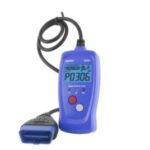The 1996 Honda Accord, like all vehicles manufactured after 1996, is equipped with an OBD2 (On-Board Diagnostics II) port. This port allows you to access diagnostic trouble codes (DTCs) to troubleshoot issues with your car. This guide will help you locate the 1996 Accord Obd2 Port and explain how to use it.
Finding the OBD2 Port on Your 1996 Honda Accord
The OBD2 port in a 1996 Honda Accord is typically located under the driver’s side dashboard, near the steering column. It’s a female, 16-pin connector, often described as a trapezoidal shape. You might need to bend down and look up under the dash to spot it. It might be partially hidden by a panel or trim piece.
Reading Diagnostic Trouble Codes (DTCs)
While dedicated OBD2 scanners are the preferred method for retrieving DTCs, you can also utilize a simple paperclip method on a 1996 Accord. This method involves jumping specific pins within the OBD2 connector to trigger the check engine light (CEL) to flash in a specific sequence, indicating the trouble codes.
Important Note: Using a paperclip is a less reliable method than a scanner, and misinterpreting the flashing codes can lead to incorrect diagnoses.
Here’s how to use the paperclip method:
-
Locate the OBD2 port: As described above, it’s under the driver’s side dash.
-
Prepare a paperclip: Straighten a paperclip and bend it into a “U” shape.
-
Identify the correct pins: Refer to your vehicle’s repair manual for the specific pins related to reading DTCs on a 1996 Accord. Commonly, it involves connecting the Service Check Connector (SC) to ground. In the image below, pins 4 and 9 are being connected.
-
Turn the ignition to the “ON” position: Do not start the engine.
-
Observe the CEL: The CEL will begin to flash. Long flashes represent the tens digit, and short flashes represent the ones digit. For example, one long flash followed by three short flashes indicates code 13.
-
Record the codes: Write down the sequence of flashes for each code.
-
Interpret the codes: Refer to a reliable source, such as a repair manual or online OBD2 code database, to decipher the meaning of each code.
Understanding OBD2 Codes
OBD2 codes are five-digit alphanumeric codes that provide insights into the specific malfunctions detected by the car’s computer.
-
The first character (a letter) indicates the system:
- P – Powertrain (engine and transmission)
- B – Body
- C – Chassis
- U – Network communication
-
The second character indicates the code type:
- 0 – Generic (standardized across all manufacturers)
- 1 – Manufacturer-specific
-
The third character indicates the subsystem: e.g., fuel system, ignition system, emissions system.
-
The last two digits are the specific fault code.
Using an OBD2 Scanner on a 1996 Accord
While the paperclip method can provide basic diagnostic information, using a dedicated OBD2 scanner is highly recommended. OBD2 scanners provide more accurate readings, can clear codes, and often offer additional data, such as live sensor readings. They are readily available at auto parts stores and online.
Conclusion
Locating and utilizing the OBD2 port on your 1996 Honda Accord is crucial for diagnosing and resolving car problems. Whether you use the paperclip method or an OBD2 scanner, understanding the codes and their meanings can empower you to address issues efficiently and keep your Accord running smoothly. Remember to consult a repair manual or a qualified mechanic for complex issues.
